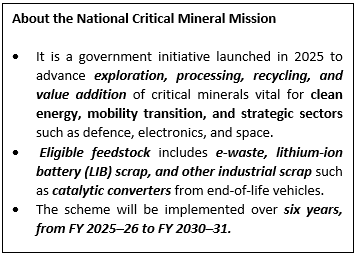National Critical Mineral Mission
Context: Recently, the Ministry of Mines has recognised two additional institutes, the Indian Institute of Science (IISc), Bangalore, and the Centre for Materials for Electronics Technology (C-MET), Hyderabad, as Centres of Excellence (CoE) under the National Critical Mineral Mission (NCMM).
More on the News

- The recognition follows the approval granted by the Project Approval and Advisory Committee (PAAC) during its meeting on 24 October 2025.
- With these additions, the total number of CoEs under NCMM has increased to nine.
- The CoEs aim to develop, demonstrate, and deploy advanced technologies through an end-to-end systems approach, advancing research to higher Technology Readiness Levels (TRL 7/8) for pilot and pre-commercial
- They will focus on strengthening India’s research and innovation ecosystem in critical minerals essential for clean energy, mobility, defence, and space applications.
53rd Chief Justice of India
Context: Recently, the Chief Justice of India, B.R. Gavai, recommended Justice Surya Kant, the senior-most judge of the Supreme Court, to succeed him as the 53rd Chief Justice of India (CJI).
More on the News

- The recommendation was made under the Memorandum of Procedure governing judicial appointments.
- Chief Justice B.R. Gavai will retire on November 23, 2025.
- Following his recommendation, the Union Ministry of Law and Justice issued a notification confirming Justice Surya Kant’s appointment.
- He was sworn in on November 24, 2025, and will serve until February 9, 2027, when he attains the age of 65 years.
- The appointment continues the judiciary’s seniority-based succession, ensuring institutional stability in the Supreme Court.
About Justice Surya Kant
- Born: February 10, 1962, in Hisar, Haryana.
- Education: Bachelor’s degree in Law from Maharishi Dayanand University, Rohtak (1984).
- Began his legal practice at Hisar District Court, later shifting to the Punjab and Haryana High Court in 1985, specialising in constitutional and service law.
- Appointed the youngest Advocate General of Haryana in 2000 and designated a Senior Advocate in 2001.
- Elevated as Judge of the Punjab and Haryana High Court in 2004, and later as Chief Justice of the Himachal Pradesh High Court in 2018.
- Appointed to the Supreme Court of India in May 2019.
- Key Judicial Contributions: Part of several landmark constitutional benches, including:
- The abrogation of Article 370 case;
- The invalidation of the Electoral Bonds Scheme;
- Cases concerning Pegasus spyware and the sedition law.
- As Executive Chairman of the National Legal Services Authority (NALSA), he has expanded legal aid, mediation, and social outreach initiatives, enhancing access to justice.
MISHTI Scheme
Context: Recently, the Union Government has undertaken the restoration and conservation of about 22,560 hectares of mangrove land under the Mangrove Initiative for Shoreline Habitats & Tangible Incomes (MISHTI).
More on the News
- A total of 22,560.34 hectares has been taken up through convergence across 13 coastal States and Union Territories for plantation and restoration of degraded mangroves during 2023–24 and 2024–25.
- Gujarat leads with 19,220 hectares under restoration, followed by Tamil Nadu (1,060 ha), Andhra Pradesh (837 ha), and Odisha (761 ha).
- Despite having the largest mangrove cover in India, West Bengal has seen only 10 hectares of land brought under MISHTI.
- According to the Forest Survey of India (FSI) 2023, India’s total mangrove cover stands at 4,991 sq. km, of which:
- West Bengal: 2,119 sq. km (≈42%)
- Gujarat: 1,164 sq. km (≈23%).
MISHTI Scheme
- Launched: June 5, 2023 (announced in the Union Budget 2023–24).
- Objective: To restore and conserve mangrove ecosystems along India’s coastline while enhancing ecological resilience and supporting sustainable livelihoods.
- The initiative focuses on reforestation and afforestation of degraded mangrove areas, serving as a natural defence against coastal erosion, cyclones, and floods.
- MISHTI contributes to India’s commitments under the Mangrove Alliance for Climate (MAC) and advances Sustainable Development Goals (SDGs) — SDG 13 (Climate Action), SDG 14 (Life Below Water), and SDG 15 (Life on Land).
India Maritime Week 2025
Context: Recently, the Ministry of Ports, Shipping and Waterways organised India Maritime Week 2025 from 27th to 31st October in Mumbai.
More on the News

- The theme of India Maritime Week 2025 is “Uniting Oceans, One Maritime Vision.”
- The Prime Minister of India addressed the Maritime Leaders Conclave and chaired the Global Maritime CEO Forum, engaging with global maritime industry leaders.
- The event will witness participation from ministers and delegations of 11 countries, representing more than 85 nations and over 100,000 delegates globally.
- IMW 2025 features 12 flagship events, including the Global Maritime India Summit (GMIS 2025), QUAD Ports of the Future Conference, Sagarmanthan – The Great Oceans Dialogue, and SheEO Conference.
- The Green Maritime Day session underlined India’s commitment to Net Zero by 2070 and reducing carbon emissions per tonne of cargo by 30% by 2030 and 70% by 2047.
- India Maritime Week, originally known as the Maritime India Summit, was first organised in 2016 and has since evolved into one of the world’s most significant global maritime platforms.
SJ-100
Context: Recently, Hindustan Aeronautics Limited (HAL) has signed a Memorandum of Understanding with Russia’s United Aircraft Corporation (UAC) to produce the SJ-100 regional passenger jet in India, marking a significant step towards indigenous civil aviation manufacturing.
More on the News
- Under this collaboration, HAL will have manufacturing rights for domestic customers, making it the first complete passenger aircraft to be produced in India since the AVRO HS-748 project (1961–1988).
- The initiative marks a significant step toward achieving ‘Aatmanirbharta’ in the civil aviation sector and strengthening regional air connectivity under the UDAN scheme.
SJ-100
- The SJ-100, earlier known as the Sukhoi Superjet 100, is a twin-engine, narrow-body regional jet designed for short to medium-haul flights.
- It has a range of about 3,530 km and can carry up to 103 passengers, making it suitable for domestic and regional operations.
- Equipped with advanced avionics and fly-by-wire technology, it offers improved safety, fuel efficiency, and performance.
- Over 200 SJ-100 jets are currently in service with more than 16 commercial airlines worldwide, reflecting proven reliability.
- The aircraft’s design focuses on lower operational costs, reduced noise and lower emissions, aligning with modern sustainability standards.

